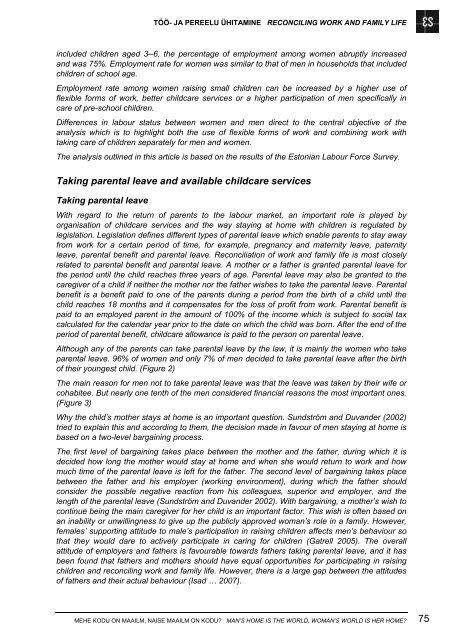MEHE KODU ON MAAILM, NAISE MAAILM ON KODU? - Tartu Ãlikool
MEHE KODU ON MAAILM, NAISE MAAILM ON KODU? - Tartu Ãlikool
MEHE KODU ON MAAILM, NAISE MAAILM ON KODU? - Tartu Ãlikool
Create successful ePaper yourself
Turn your PDF publications into a flip-book with our unique Google optimized e-Paper software.
TÖÖ- JA PEREELU ÜHITAMINE REC<strong>ON</strong>CILING WORK AND FAMILY LIFE<br />
included children aged 3–6, the percentage of employment among women abruptly increased<br />
and was 75%. Employment rate for women was similar to that of men in households that included<br />
children of school age.<br />
Employment rate among women raising small children can be increased by a higher use of<br />
flexible forms of work, better childcare services or a higher participation of men specifically in<br />
care of pre-school children.<br />
Differences in labour status between women and men direct to the central objective of the<br />
analysis which is to highlight both the use of flexible forms of work and combining work with<br />
taking care of children separately for men and women.<br />
The analysis outlined in this article is based on the results of the Estonian Labour Force Survey.<br />
Taking parental leave and available childcare services<br />
Taking parental leave<br />
With regard to the return of parents to the labour market, an important role is played by<br />
organisation of childcare services and the way staying at home with children is regulated by<br />
legislation. Legislation defines different types of parental leave which enable parents to stay away<br />
from work for a certain period of time, for example, pregnancy and maternity leave, paternity<br />
leave, parental benefit and parental leave. Reconciliation of work and family life is most closely<br />
related to parental benefit and parental leave. A mother or a father is granted parental leave for<br />
the period until the child reaches three years of age. Parental leave may also be granted to the<br />
caregiver of a child if neither the mother nor the father wishes to take the parental leave. Parental<br />
benefit is a benefit paid to one of the parents during a period from the birth of a child until the<br />
child reaches 18 months and it compensates for the loss of profit from work. Parental benefit is<br />
paid to an employed parent in the amount of 100% of the income which is subject to social tax<br />
calculated for the calendar year prior to the date on which the child was born. After the end of the<br />
period of parental benefit, childcare allowance is paid to the person on parental leave.<br />
Although any of the parents can take parental leave by the law, it is mainly the women who take<br />
parental leave. 96% of women and only 7% of men decided to take parental leave after the birth<br />
of their youngest child. (Figure 2)<br />
The main reason for men not to take parental leave was that the leave was taken by their wife or<br />
cohabitee. But nearly one tenth of the men considered financial reasons the most important ones.<br />
(Figure 3)<br />
Why the child’s mother stays at home is an important question. Sundström and Duvander (2002)<br />
tried to explain this and according to them, the decision made in favour of men staying at home is<br />
based on a two-level bargaining process.<br />
The first level of bargaining takes place between the mother and the father, during which it is<br />
decided how long the mother would stay at home and when she would return to work and how<br />
much time of the parental leave is left for the father. The second level of bargaining takes place<br />
between the father and his employer (working environment), during which the father should<br />
consider the possible negative reaction from his colleagues, superior and employer, and the<br />
length of the parental leave (Sundström and Duvander 2002). With bargaining, a mother’s wish to<br />
continue being the main caregiver for her child is an important factor. This wish is often based on<br />
an inability or unwillingness to give up the publicly approved woman’s role in a family. However,<br />
females’ supporting attitude to male’s participation in raising children affects men’s behaviour so<br />
that they would dare to actively participate in caring for children (Gatrell 2005). The overall<br />
attitude of employers and fathers is favourable towards fathers taking parental leave, and it has<br />
been found that fathers and mothers should have equal opportunities for participating in raising<br />
children and reconciling work and family life. However, there is a large gap between the attitudes<br />
of fathers and their actual behaviour (Isad … 2007).<br />
<strong>MEHE</strong> <strong>KODU</strong> <strong>ON</strong> <strong>MAAILM</strong>, <strong>NAISE</strong> <strong>MAAILM</strong> <strong>ON</strong> <strong>KODU</strong>? MAN’S HOME IS THE WORLD, WOMAN’S WORLD IS HER HOME? 75

















